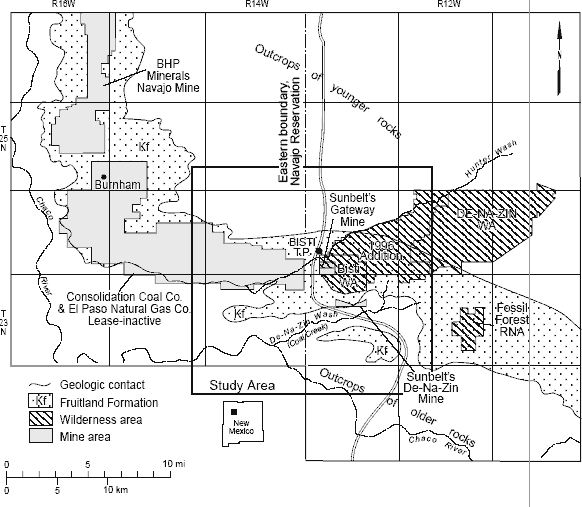
COAL AVAILABILITY STUDY-BISTI AREA, NORTHWEST NEW MEXICO
Coal is an important part of New Mexico's economy and contributes substantially to the state's educational funds through royalties and taxes. The state ranked 12th in the nation in coal production with 22.9 million short tons (st), in 2012. Almost two-thirds of this product was used for electrical generation. Coal-fired power plants are close to the mines because of the high cost (average cost- $34.79/st, 2012) of New Mexico coal. Prices are high because the coal seams are lenticular and relatively thin (less than 20 ft): therefore companies mine multiple seams. Compared to other western states, in particular Wyoming, New Mexico coal is expensive to mine because the ratio of overburden to seam thickness prohibits transporting the product over long distances. The lack of adequate rail transportation in the San Juan Basin (SJB), northwest New Mexico, also plays a part in limiting markets for New Mexico coal. Economics dictate transmitting electricity from the SJB to other western and Pacific Coast states rather than shipping the coal.
Approximately 60% of New Mexico's coal production is from the Late Cretaceous Fruitland Formation. This unit has some of the thickest coals mined in the SJB and they are more continuous over short distances than other coal-bearing sequences (Menefee and Crevasse Canyon Formations) in the basin. BHP Minerals operate two of the four New Mexico mines: the San Juan and Navajo mines; and produce coal from the Fruitland Formation. The Navajo mine is the 24th largest mine in the nation and produced 7.6 million st in 2012. This mine has been operating for 50 years with total output of over 352 million st.
With the above economic and geologic factors considered, four quadrangles on the northeast edge of the Bisti field were chosen for this study (Fig. 1). This area (238 sq mi) along the Fruitland outcrop has economic potential because of its proximity to the existing power plants and for the relative continuity of the coal seams. The southern extent of BHP Minerals Navajo mine is approximately 16 mi northwest of the study area and the recently relinquished leases of the Conpaso mine (El Paso Natural Gas Navajo Lease) are immediately west of the study area (Fig. 1). Within this tract, two small mines, the De-Na-Zin and Gateway, were in production during the 1980s.


